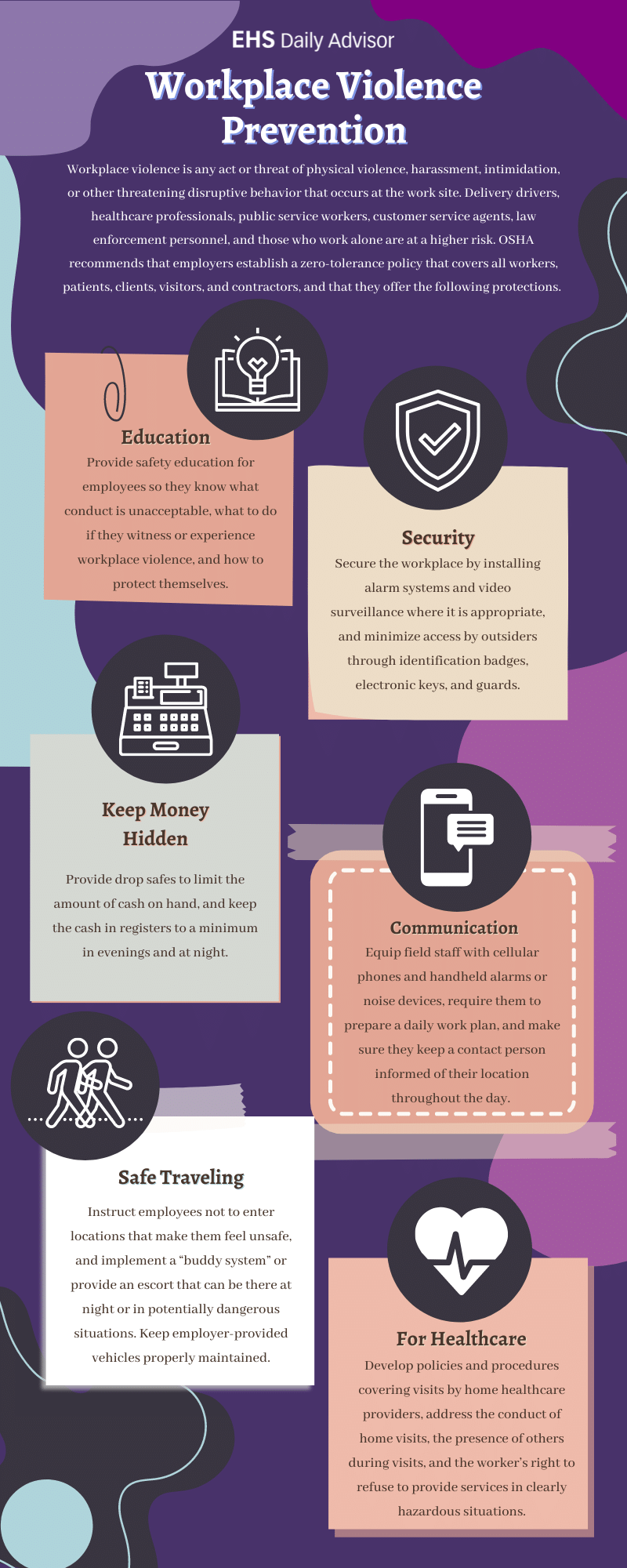The Role of Employee Training and Awareness in Enhancing Work Environment Violence Prevention Initiatives Across Different Industries
The assimilation of employee training and understanding into work environment violence prevention efforts is progressively identified as a basic facet of organizational safety across diverse sectors. Recognizing these nuances may reveal methods that can significantly enhance security procedures and worker self-confidence in risky settings.
Relevance of Educating Programs
In today's vibrant job environment, the significance of training programs can not be overstated, especially in the context of workplace violence prevention. These programs work as a fundamental component in cultivating a safe and safe and secure workplace society. By gearing up employees with the expertise and skills essential to identify, reduce, and respond to prospective dangers, organizations can cultivate a setting that focuses on safety and security and health.
Efficient training programs do even more than simply instruct; they encourage workers to recognize indication of violence, comprehend the methods for reporting incidents, and establish strategies to de-escalate possible problems. In addition, they instill a feeling of cumulative duty among team, motivating positive engagement in preserving a secure work environment.
Financial investment in training not only improves employee understanding yet also shows a company's commitment to protecting its labor force. This positive strategy can cause lowered incidents of work environment physical violence, reduced absence, and enhanced worker morale. Ultimately, thorough training programs are essential to establishing a resistant organizational society that values safety and advertises a healthy and balanced job environment, therefore minimizing the risk of violence and its linked effects.
Key Components of Effective Understanding
A thorough understanding program incorporates a number of key elements that are vital for efficiently stopping work environment physical violence. Clear communication of treatments and policies connected to work environment violence is essential. Staff members have to be notified regarding the company's position on physical violence and the particular procedures in place for reporting cases.
Second, training sessions should incorporate practical scenarios that staff members may come across. This functional approach aids workers recognize advising indications of prospective physical violence and outfits them with the essential skills to de-escalate strained situations. Third, fostering a supportive workplace society is crucial; staff members should really feel empowered to speak up without worry of revenge.
Additionally, ongoing education is necessary to keep understanding fresh and appropriate. Routine correspondence course and updates on emerging dangers can improve staff members' watchfulness and readiness. Integrating feedback mechanisms allows employees to share their insights and experiences, which can lead to constant renovation of awareness efforts. By incorporating these parts, companies can create a durable framework for preventing workplace physical violence, ultimately contributing to a more secure and more effective atmosphere for all employees.
Industry-Specific Training Strategies
Efficient workplace violence avoidance training should be tailored to the one-of-a-kind obstacles and threats dealt with by particular markets. As an example, medical care atmospheres need training that resolves the high possibility of experiences with aggressive people or visitors. Programs need to concentrate on de-escalation strategies, recognizing warning indicators of potential physical violence, and ensuring team recognize the value of reporting cases.
On the other hand, retail settings might deal with various hazards, such as break-in or customer disputes. Training in these atmospheres need to stress situational understanding, reaction methods throughout emergencies, and the importance of protecting money and valuables.
Production and building and construction sectors provide their very own dangers, commonly related to interpersonal conflicts or dangerous working conditions. Training in these fields should consist of strategies for problem resolution, advertising a culture of security, and encouraging open communication among workers.
Additionally, company offices may need training fixated preventing harassment and bullying, fostering a respectful work environment culture, and carrying out clear coverage devices. Each sector has to not only acknowledge its certain susceptabilities yet also adapt training products to resonate with the workforce efficiently, guaranteeing that staff members feel complete and encouraged to handle prospective terrible scenarios.
Measuring Educating Effectiveness
Assessing the impact of workplace physical violence avoidance training is vital for guaranteeing that employees are properly prepared to take care of potential threats. Pre- and post-training studies can determine modifications in employee understanding, attitudes, and behaviors concerning work environment physical violence.
Furthermore, functional assessments, such as role-playing scenarios or simulations, can provide understandings right into how well workers use found out abilities in real-life circumstances. Keeping track of incident records before and after training can likewise function as an indication of performance, as a decrease in events may reflect improved staff member readiness.
In addition, comments from individuals need to be systematically accumulated to determine locations for enhancement in training content and shipment. Carrying out follow-up examinations at routine periods aids sustain awareness and reinforces training concepts in time - look at this now california workplace violence prevention. By utilizing an extensive technique to gauging training performance, companies can ensure that their work environment violence avoidance campaigns promote a safer atmosphere and boost general worker well-being
Building a Society of Safety And Security

Educating plays a pivotal function in this social shift. Routine, detailed training sessions inform staff members about identifying indication of office violence and the proper feedbacks. Urging open communication enables workers to voice problems without worry of retaliation, promoting collective responsibility for safety.
In addition, integrating security into everyday operations makes certain that it ends up being a shared worth instead than a mere conformity problem. This includes normal safety and security drills, updates on policies, and responses mechanisms that include staff members in safety and security discussions and improvements.
Ultimately, a robust culture of safety and security not only minimizes the risks of office physical violence but likewise boosts worker morale and productivity. By promoting an atmosphere where security is an essential top priority, organizations can develop resilient workplaces that sustain both have a peek at this website specific well-being and cumulative success.
Final Thought
In verdict, employee training and recognition are vital elements in the avoidance of workplace violence across different markets. Effective training programs, customized to certain market demands, enhance staff members' capability to respond and identify to potential hazards. By applying detailed awareness techniques and promoting a society of safety, companies can considerably lower occurrences of work environment physical violence and boost general staff member morale. Dedication to recurring training and assessment makes sure continual performance and flexibility in dealing with arising challenges within the workplace atmosphere.

Regular, thorough training my sources sessions inform workers regarding identifying caution indications of work environment violence and the ideal feedbacks.In final thought, worker training and recognition are crucial parts in the avoidance of work environment violence across different industries.